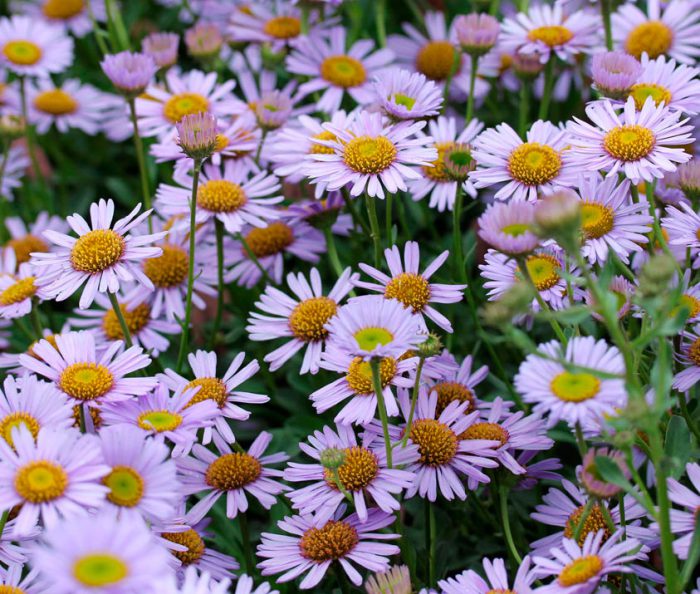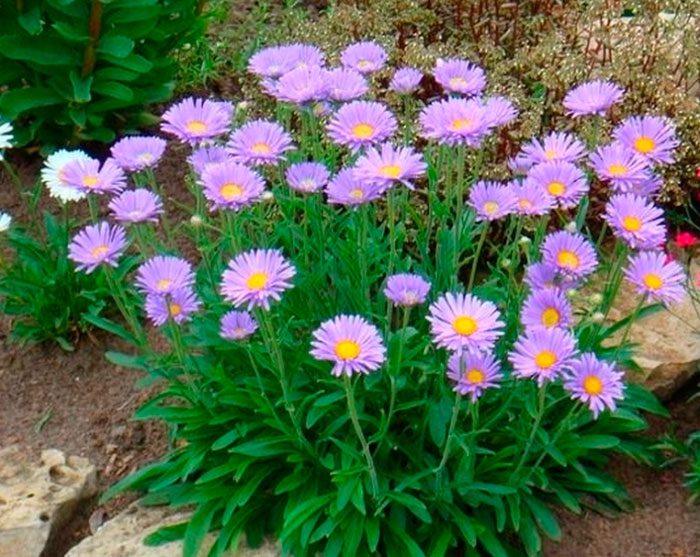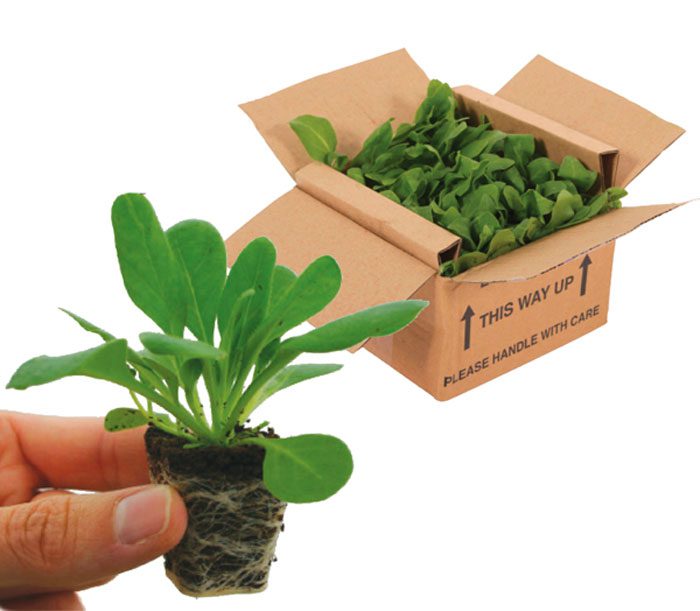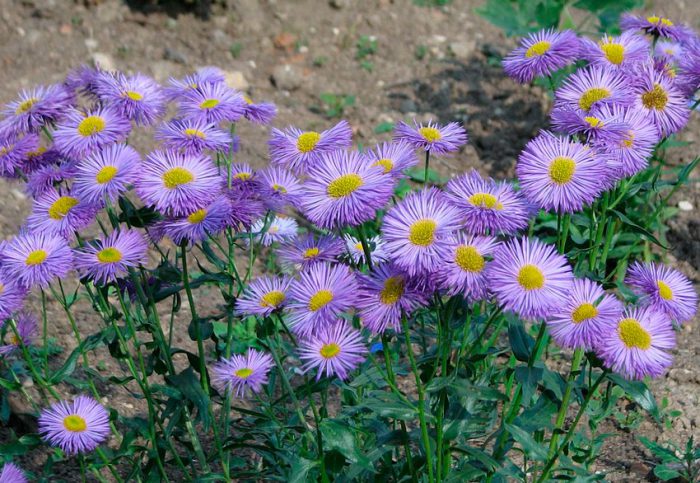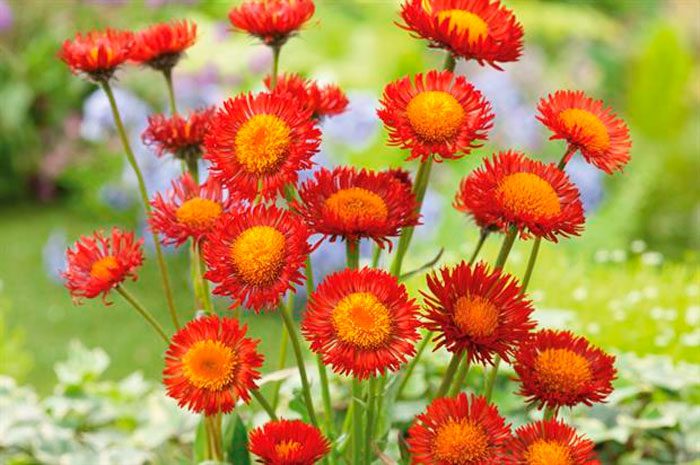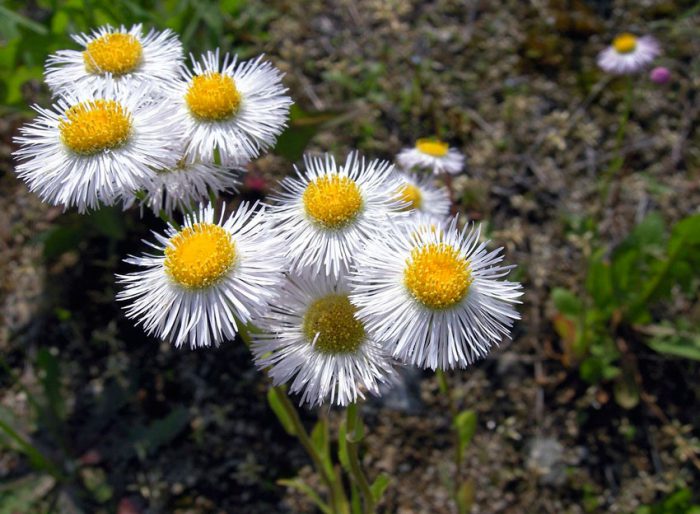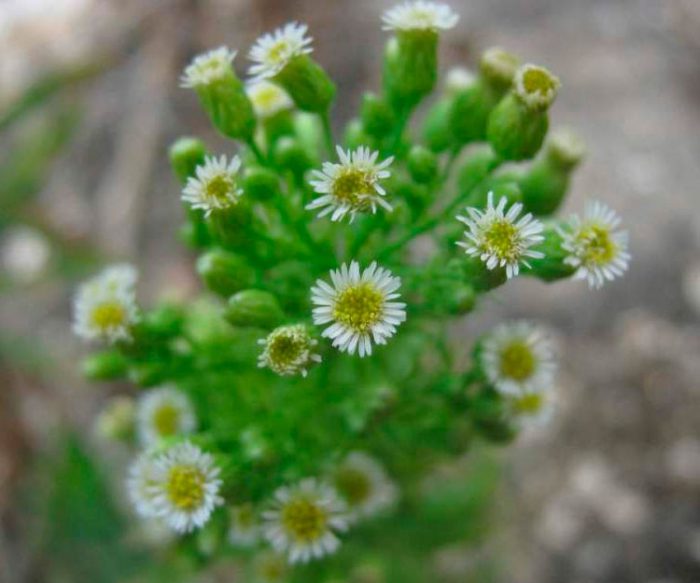The flowering herb Erigeron, also called small-petal, is a member of the Asteraceae family. According to information taken from various sources, this genus unites 200-400 species, while 180 of them can be found in the wild in North America. Certain types of erigeron are cultivated as ornamental plants. The name of this flower comes from two Greek words that translate as "old man" and "early", the fact is that the seeds of the small-petal develop rapidly and there is a grayish crest on them.
Content
- 1 Small petals features
- 2 Landing of Erigeron (small-petaled)
- 3 Small petals care
- 4 Types and varieties of small petals with photos and names
- 4.1 Beautiful small petal (Erigeron speciosus = Stenactis speciosa)
- 4.2 Small-petaled Karvinsky (Erigeron karvinskianus = Erigeron mucronatus)
- 4.3 Erigeron orange (Erigeron aurantiacus)
- 4.4 Erigeron alpine (Erigeron alpinus = Erigeron schleicheri)
- 4.5 Small petals acrid (Erigeron acris), or small petals acute
- 4.6 One-year-old small petal (Erigeron annuus)
- 4.7 Canadian small petals (Erigeron canadensis)
Small petals features
Erigeron is a herbaceous rhizomatous perennial, biennial or annual plant; dwarf shrubs are also found in this genus, outwardly similar to perennial asters. Small branched, simple, rough shoots can be slightly lodging or straight. Basal elongated-oblong leaf plates are assembled into a rosette, their length is about 20 centimeters, they can be shallow-lobed or solid. Baskets can be placed on the shoots singly or be part of the inflorescence of the corymbose or paniculate form. The baskets include 1–3 rows of marginal reed and median tubular flowers. The middle flowers are yellow in color, while the reed flowers are painted in purple, white, lilac, pink, purple or cream. The fruit is an achene that can be glabrous or densely pubescent.
Landing of Erigeron (small-petaled)
Erigeron can be propagated by cuttings, seeds and dividing the bush. Seeds are sown at the beginning of spring or before winter. Some species are tightly similar, so it is recommended to grow them through seedlings. In this case, sowing should be done in March. Fill a wide container with a moistened substrate. Seeds are sparsely distributed over the surface of this soil mixture and without deepening, they just slightly press them into the ground. The container must be tightly covered with foil or glass. The container with seeds should be transferred to a cool place, which should be well lit.As a rule, the first seedlings should appear no earlier than 4 weeks later. Maturing plants gradually begin to grow and develop faster and faster.
If the crops are too dense, then after the plants have a second true leaf, they will need to dive. The seedlings will still be very small, but this should not bother you. In the event that the seedlings do not grow very densely, then they do not need a pick, in the first summer days they can be transplanted directly into open soil. Seedlings should not be kept warm for a long time. When she grows up and gets stronger, you will need to move her to the veranda or to the loggia.
These plants are very fond of light, but they can also be grown in partial shade. Almost any soil is suitable for growing, however, it is not recommended to grow Erigeron on moist soil, since its development and growth in this case will be very slow. It is best for planting to choose a well-lit area with alkaline soil that is not oversaturated with nutrients.
Planting seedlings in open ground should be done in June, while bushes must be removed from the containers along with a lump of earth. Do not forget to keep a distance of 25 to 30 centimeters between copies. Small petals grown by seed will begin to bloom only in the second year of life.
Small petals care
Planting a small petal is as easy as caring for it. Such flowers must be regularly watered moderately, after which the soil surface is loosened between the rows and at the same time the weeds are pulled out. You don't need to feed them. However, if you want erigeron to bloom for a longer time, and its flowers have the most spectacular appearance, then during the period of bud formation, feed it with complex mineral fertilizer.
When the growing season is over, the aboveground parts of the bushes must be cut off. If an erigeron perennial is grown, then in regions with frosty winters it will need to be covered with dried grass or foliage.
If the summer period turned out to be rainy, then the small-petaled bushes can be affected by fungal infections. In an infected specimen, specks of dark brown color are formed on the surface of the leaf plates. After the first signs of the disease are detected, the bushes should be treated with a Bordeaux mixture (1%), it is repeated 3 or 4 times, while the interval between procedures should be 1.5 weeks. Also, the bushes can be sprinkled with wood ash. If the plant is very badly affected, then its ground part is completely cut off and destroyed, while the soil must be shed with any fungicide.
Every 3 or 4 years, erigeron, which is a perennial, needs to be rejuvenated. To do this, you should remove a bush from the ground, divide it into parts and plant it. Such a flower tolerates the procedure for dividing a bush easily.
Types and varieties of small petals with photos and names
Gardeners cultivate several different types of small petals, as well as a large number of their varieties and hybrids.
Beautiful small petal (Erigeron speciosus = Stenactis speciosa)
This type is most popular with gardeners. Under natural conditions, it can be found in the western regions of North America. Such a perennial plant has a short horizontal rhizome. The height of erect, branched leafy shoots can reach up to 0.7 m, their surface is rough. The shape of the basal leaf plates is spatulate, and the stem ones are lanceolate. Baskets are part of large scutes, they contain yellow tubular and lilac reed flowers. This species blooms in July or August, flowering duration is about 1 month. Cultivated since 1826 Popular varieties:
- Violet. The variety is terry. The color of the reed flowers is dark purple.
- Wuppertal. Bush reaches a height of 0.45 m. The diameter of the baskets is about 50-60 mm. There are 3 rows of lilac reed flowers.
- Dunkelshnee Adler. The color of the reed flowers is ultramarine.
- Lilofee. The variety is semi-double. The color of the flowers is dark lilac.
- Sommernear. The bush reaches a height of about 0.6 m. The diameter of the baskets is no more than 40 mm. Reed flowers, by the end of flowering, change their white color to pink.
- Rose of Triumph. The variety is terry. The color of the reed flowers is dark pink.
- Festers Leibling. The variety is terry. The color of the reed flowers is pink.
- Rote Shengayt. The variety is semi-double. Ligulate flowers are colored red-pink.
- Prosperity. The color of the reed flowers is pale blue.
Small-petaled Karvinsky (Erigeron karvinskianus = Erigeron mucronatus)
This species comes from Central America, gardeners began to cultivate it not so long ago, so it is not yet very popular. Where he comes from, such plants are perceived as weeds. His bush is quite compact and does not exceed 15 centimeters in height. If desired, it can be grown in a basket, container or any other suspended structure. If you grow such an erigeron in open soil, the diameter of the bush can reach about 0.6 m.At the tops of thin branched shoots throughout the summer period, baskets that look like small pink daisies grow. The baskets gradually change their color to white, and then turn back to a deep pink-red color.
Erigeron orange (Erigeron aurantiacus)
Under natural conditions, this species is found in the northwestern regions of China and in Central Asia. The height of the bush can reach 0.3–0.4 m, and its diameter does not exceed 0.5 m. On straight shoots there are oblong-oval leaf plates. The diameter of single inflorescences-baskets is about 30 mm, they include ligulate orange and tubular yellow flowers. Cultivated since 1879
Erigeron alpine (Erigeron alpinus = Erigeron schleicheri)
The height of the bush is about 0.3 m, in natural conditions this flower is found in Central and Western Europe, as well as in Asia Minor. This perennial has straight shoots with a rough surface. The shape of the basal leaf plates is linear-lanceolate, and in rare stem sessile ones - elongated. The diameter of single inflorescences of baskets varies from 30 to 35 mm, they include mauve reed and yellow tubular flowers. Blooms in the second half of June, flowering duration is about 6 weeks. Cultivated since 1759
Small petals acrid (Erigeron acris), or small petals acute
This variable species is a biennial, it has a large number of forms. The height of the bush can vary from 0.06 to 0.75 m. As a rule, the plant has 1 erect, branched shoot, on the surface of which there is pubescence, it is colored purple or green. The color of the leaf plates is green, very rarely pubescence can be seen on their surface. Baskets are part of panicle inflorescences, the color of the tubular flowers is yellow, and the reed flowers are pink.
One-year-old small petal (Erigeron annuus)
This species is invasive, it came to European countries from North America. The height of the bush can vary from 0.3 to 1.5 m. The straight shoot is covered with sparse bristles, at the top it branches. The color of the hairy-bristly leaf plates is green. There are a large number of baskets, which are part of corymbose or panicle inflorescences, reaching 10-15 centimeters in diameter. The baskets include tubular yellow and 2 rows of false-lingual white or light blue flowers. Today this species is not grown as an ornamental plant. In gardens, it is present only as a weed.
Canadian small petals (Erigeron canadensis)
This annual plant does not have a decorative appearance, but it is used in alternative medicine, as it can stop uterine bleeding.Small baskets consist of tubular light yellow and reed white flowers.
In addition to these species, such species are also cultivated as: single-flowered, naked, drooping, northern, elongated and woolly-celled. But only some of them have a decorative appearance.

